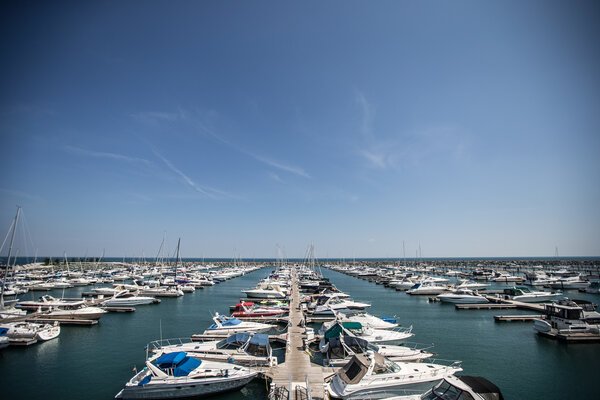Certified Dealers
A new boat is an investment that will bring you and your family years of fun. Be sure to buy it from a dealership that has invested in making sure you will enjoy every one of those years. Choose a Marine Industry Certified Dealership.
The Marine Industry Certified Dealership Program is a voluntary process. Dealerships that earn Marine Industry Certification have made a commitment to your complete satisfaction. They also pledge to post and abide by a Marine Industry Consumer Commitment that ensures fair and equal treatment for every single customer. Dealers who have reached the highest level of Certification are considered Five Star Marine Industry Certified Dealers. They must demonstrate to a third party reviewer that they meet or exceed program standards in key areas, including customer service, employee satisfaction, facility and business practices. They must commit to follow up with 100 percent of their customers. And to confirm their dedication, they are re-certified every two years.
Your Marine Industry Certified Dealership will help you choose the right boat for your lifestyle and your needs, maintain your boat and provide service when it’s needed. To find a participating dealership, look for the Marine Industry Certified Dealership logo.
MRAA Certified Dealers
- Look for MRAA Certified Dealership logo when researching dealerships in your area
- MRAA Certified Dealerships are dealers who have invested in becoming the best of the best. These dealerships aim for superior customer satisfaction by supporting you with top notch service in every department during the entire boat buying and ownership process.

Buying from a Marine Industry Certified Dealership
The Marine Industry Dealership Certification Program is designed to ensure that buying and maintaining a boat are pleasant experiences. When you visit a Marine Industry Certified Dealership, you can feel confident you're choosing a business that is committed to your satisfaction, both in terms of product and service. You can expect:
- Friendly, knowledgeable employees
- Quality products
- Reliable service
How Dealers Become Certified
To become Certified, a dealership must demonstrate its commitment to excellence by meeting high standards in several key areas:
- Operations
- Facilities
- Professional sales/service processes
- Customer satisfaction
- Employee training/satisfaction
Benefits of Buying from a Marine Industry Certified Dealership
- A marine industry Consumer Commitment
- Assurance of dealership's commitment to excellence
- Guaranteed opportunity to provide feedback and resolve issues
How to find an MRAA Certified Dealer
- View Certified Dealers
- Visit Discover Boating Boat Shows, Most show directories indicate which dealers are MRAA Certified Dealers who are exhibiting in the show.
- Look for the MRAA Certified Dealership logo or ask the dealer you are working with if they are a member of the MRAA and committed to continuous improvement through education and training.
Why Should You Buy from an MRAA Marine Industry Certified Dealer?
- Buying a boat from an MRAA Certified Dealership gives you the peace of mind that you are making a sound investment with a dealer who prioritizes your satisfaction and long-term relationship.
What does an MRAA Certified Dealership deliver?
- Assurance of Quality: A dealership that has earned this certification has undergone a rigorous process to meet the highest standards in customer service, dealership operations, and overall professionalism. This gives consumers confidence that they are dealing with a reputable and trustworthy dealer.
- Customer-Centric Approach: Certified dealers are committed to providing you with superior experience. This means focusing on understanding your needs, offering personalized service, and maintaining transparency throughout the buying process.
- Trained and Knowledgeable Staff: Dealers invest in continuous training, ensuring that they are knowledgeable about the latest products and technologies. This means you can expect informed guidance and expert advice when purchasing a boat.
- After-Sales Support: Certified dealers typically provide excellent after-sales support, including maintenance, repairs, and warranty services. This ensures that you have ongoing support long after your purchase.
- Commitment to Ethical Practices: Certified Dealers adhere to a strict code of ethics, ensuring that all business practices are fair, transparent, and in the best interest of their customer.
How does a dealer become an MRAA Certified Dealership?
- Dealers who are committed to improving every aspect of their dealership enroll in the MRAA Certified Dealer program.
- Dealers who electively decide to become certified will go through an extensive educational and training process developed by dealers – for dealers, to become MRAA Certified.
- To uphold their MRAA Certification, a dealer must enroll in the annual continuous certification program to keep up to date with new systems, practices and processes to consistently deliver an exceptional customer experience through the boat buying and ownership experience.

How do I know if a Dealer is MRAA Certified?
- Look for the MRAA Certified Dealer logo when searching for dealers near you on the Discover Boating Dealer Finder.
- Look for the MRAA Certified Dealer logo on the window of your local dealership or simply as the staff.
